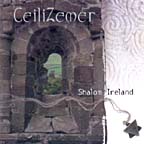CeiliZemer / Shalom Ireland
 CeiliZemer
CeiliZemer
Shalom Ireland
CeiliZemer, 2003
Web: www.shalomireland.com
To purchase and listen to sound clips: www.cdbaby.com
It has always seemed that Irish music and klezmer should fuse. After all, who but the people who created the Book of Kells could appreciate the people of the Book, and vice versa. The problem is finding people who understand the feel for both musics, and who can create something that represents both traditions and something new, their fusion, fairly
Given their ability to fuse klezmer with bluegrass, it comes as no surprise that members of the Sacramento, California-based band, the Freilachmaker Klezmer String Band would be the right folks to approach on such a project. Along with friends from a local Irish band, "Driving with Fergus," they decided to fuse the two traditions for the soundtrack for a documentary about the Jewish community of Ireland, "Shalom, Ireland." Fusing the Gaelic word for "party" and the Hebrew word for song, the band called itself "CeiliZemer" (pronounced, I believe, "kaylee-zemer" or "kaylayzemer").
The result is a lovely mix of the two traditions. The opening Irish pipes quickly give way to an Irish-sounding string band "Naftule Shpilt far dem Rebn" and then the tunes go back and forth in the most lovely fashion. This is even more remarkable when you consider that the instrumentation includes a full range of traditional Irish musicmakers: whistel, uillean pipes, etc., that are not usually thought of as klezmer instruments. But then, they do quite well as CeiliZemer instruments, indeed, although, hearing the "Sadegurer Khosid" through Irish eyes is an eye-opening, if also toe-tap pleasing experience. As the band says, this is, indeed, how "Dem Trisker Rebns Khosid" might have sounded like if the Rebbe had B pipes. The vocals are equally well done: "Yom Shabbaton" is a perfect Sabbath pleasure. The penultimate "The Parting Glass" is the perfect early in the morning as we drift off to sleep, or anytime, off on the ship departure song. In the end, the music makes clear what I presume is also documented in the movie, that Irish and Jewish souls go well together, and did so well for a good time.
I'm not sure how "Irish" this all sounds. To my Jewish ears, it is absolutely Irish, with wonderfully well-played jigs and reels of the choicest selection and best playing, from those opening jigs, past the Crooked Road to Dublin, through the Lament for Limerick and on. Certainly, there are places where it sounds strangely Jewish (that is, Jewish, but even so, strange). But then, the music does fuse together nicely, and the result is something new, interesting, and most pleasing to the ear. Planxty Ginsberg, and alleged Jew-rish waltz, is, indeed, hauntingly beautiful, and a waltz. The handclaps providing percussion for "Hatikvah" are absolutely right. I'd love to try to do the same at the next gathering where "Hatikvah" is sung in this country. The "Hora mit tsibeles" is an excellent example of Irish percussion and Jewish fiddle, and a lovely clawhammer banjo to hold it all together. The critical piece, I suspect, is that these tunes are all played at danceable tempos, by people who are clearly used to playing for contradancers and Jewish dancers. That makes a difference.
Reviewed by Ari Davidow 11/23/03
Personnel this recording:
David Kidron: fiddle, whistle (trks 11, 13), vocal (trk 13)
Andy Rubin: 5 string & tenor banjos, mandolin, vocal, guitar (trk 8)
Vince Wolfe: flute, B uillean pipes, whistle, guitar (trks 2, 6), bodhran
Lewis Santer: guitar, bouzouki, mandolins (melody: trks 3, 9; rhythm: trk 2)
LaRita Craft: accordion
Julie Hochman: cello
Sean Feder: percussion (trk 3)
Shawn King: recording engineer, hand claps
Songs
- Jig/boy on the Mountain Top/The boys of Portaferry (jig: trad., after Kit Slawson; reels: trad., after Harry Bradley) 3:55
- Naftule Shpilt far dem Rebn--Naftule plays for the rabbi (trad., after Naftule Brandwein) 5:24
- Khosn kale mazltov--Congratulations to the groom and bride (Sigmund "Zelig" Mogulesko) 2:29
- Poirt na bPúcaí/Cordal jig (McWeeney's) (trad., via Ronan Browne/trad., via Edel McWeeney) 6:59
- Sadegurer Khosid--Hasidic dance from Sadegora (after Joseph Moskowitz) 3:25
- Hora mit tsibeles--hora with onions (trad., after Brandwein) 5:17
- Crooked road to Dublin/The Virginia (trad.) 3:45
- Yom Shabbaton--Sabbath Day (trad.?)) 4:13
- Planxty Ginsberg (L. Santer) 3:51
- Hatikvah--the hope (Israel's national anthem) (Cohen/Imber) 1:48
- Lament for Limerick (trad., from David Kidron) 4:31
- Dem Trisker Rebns Khosid--Hasidic dance of the Rebbe of Trisk (trad., after Alicia Svigals) 3:18
- the Parting Glass ((trad.) 4:40
- Hatikvah (Reprise) 1:52

